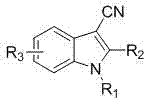3-cyanoindole compound synthesis method
A technology of cyanoindole and synthesis method, applied in directions such as organic chemistry, can solve problems such as high price, easy poisoning of Pd catalyst, and achieve the effects of mild reaction conditions, simple operation method and low production cost
- Summary
- Abstract
- Description
- Claims
- Application Information
AI Technical Summary
Problems solved by technology
Method used
Image
Examples
Embodiment 1-20
[0019] Example R 1 R 2 R 3 1 H H H 2 H CH 3 H 3 H Ph H 4 H H 5-OCH 3 5 H H 5-Cl 6 H H 4-Cl 7 H H 5-F 8 H H 6-COOCH 3 9 H H 5-NO 2 10 H (4-F)-Ph H 11 H H 5-CN 12 H H 5-CH 3 13 CH 3 H H 14 CH 3 H 5-NO 2 15 CH 3 H 5-CN 16 CH 3 H 5-OCH 3 17 CH 3 H 5-CH 3 18 CH 3 Ph 5-OCH 3 19 CH 2 CH 3 CH 3 H 20 CH 2 CH 3 Ph H
Embodiment 1
[0021] Room temperature (20-35 o C) Add indole (1.0mmol), CuI (1.2mmol), phenylacetonitrile (1.2mmol) and DMF (5ml) in turn to the reaction flask, then stir and heat to 100 o C reaction until the PLC tracking indole reaction is complete. After the reaction, the reaction solution was cooled to room temperature, then added to 20ml of water, and extracted three times with dichloromethane, using 10ml of dichloromethane each time, separated by silica gel chromatography column, and distilled under reduced pressure. The yield was 80%, and the identification result was: 1 H NMR (400 MHz, CDCl 3 ) δ 8.80 (s, 1H), 7.78 (dd, J = 8.2, 7.2 Hz, 1H), 7.76 (s, 1H), 7.48 (dd, J = 8.3, 6.8 Hz, 1H), 7.39 – 7.28 (m, 2H). 13 C NMR (126 MHz, CDCl 3 ) δ 135.00, 132.05, 127.09, 124.45, 122.52, 119.80, 116.05, 112.23, 87.53.
Embodiment 2
[0023] Room temperature (20-35 o C) Add 2-methylindole (1.0mmol), CuI (1.2mmol), phenylacetonitrile (1.2mmol) and DMF (5ml) in turn in the reaction flask, then stir and heat to 100 o C reaction until the PLC tracking 2-methylindole reaction is complete. After the reaction, the reaction solution was cooled to room temperature, then added to 20ml of water, extracted three times with dichloromethane, each time using 10ml of dichloromethane, separated by silica gel chromatography, and distilled under reduced pressure. The yield was 37%, and the identification result was: 1H NMR (400 MHz, DMSO) δ 12.12 (s, 1H), 7.55 (d, J = 7.5 Hz, 1H), 7.47 (d, J = 7.8 Hz, 1H), 7.27 – 7.17 (m, 2H), 2.58 (s, 3H). 13 C NMR (101 MHz, DMSO) δ 146.90, 135.75, 128.13, 123.59, 122.31, 118.64, 117.42, 112.96, 83.75, 13.47.
PUM
 Login to View More
Login to View More Abstract
Description
Claims
Application Information
 Login to View More
Login to View More - R&D
- Intellectual Property
- Life Sciences
- Materials
- Tech Scout
- Unparalleled Data Quality
- Higher Quality Content
- 60% Fewer Hallucinations
Browse by: Latest US Patents, China's latest patents, Technical Efficacy Thesaurus, Application Domain, Technology Topic, Popular Technical Reports.
© 2025 PatSnap. All rights reserved.Legal|Privacy policy|Modern Slavery Act Transparency Statement|Sitemap|About US| Contact US: help@patsnap.com

